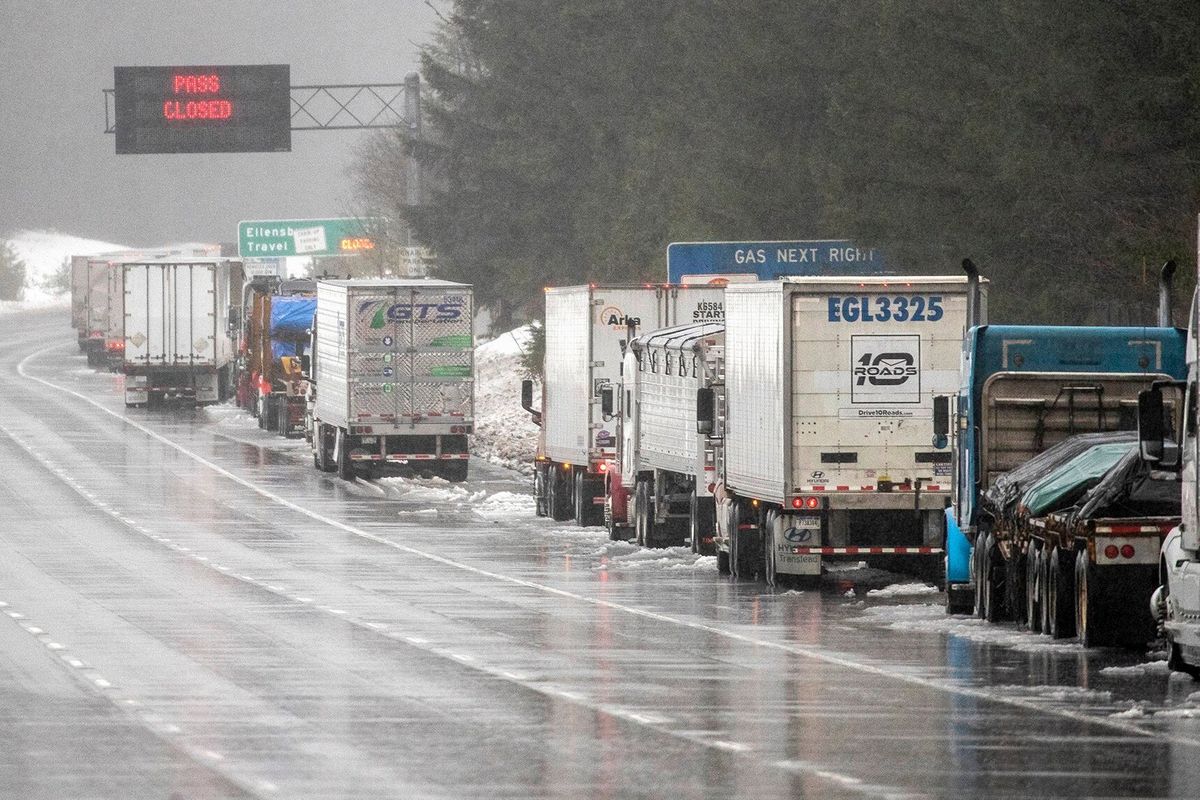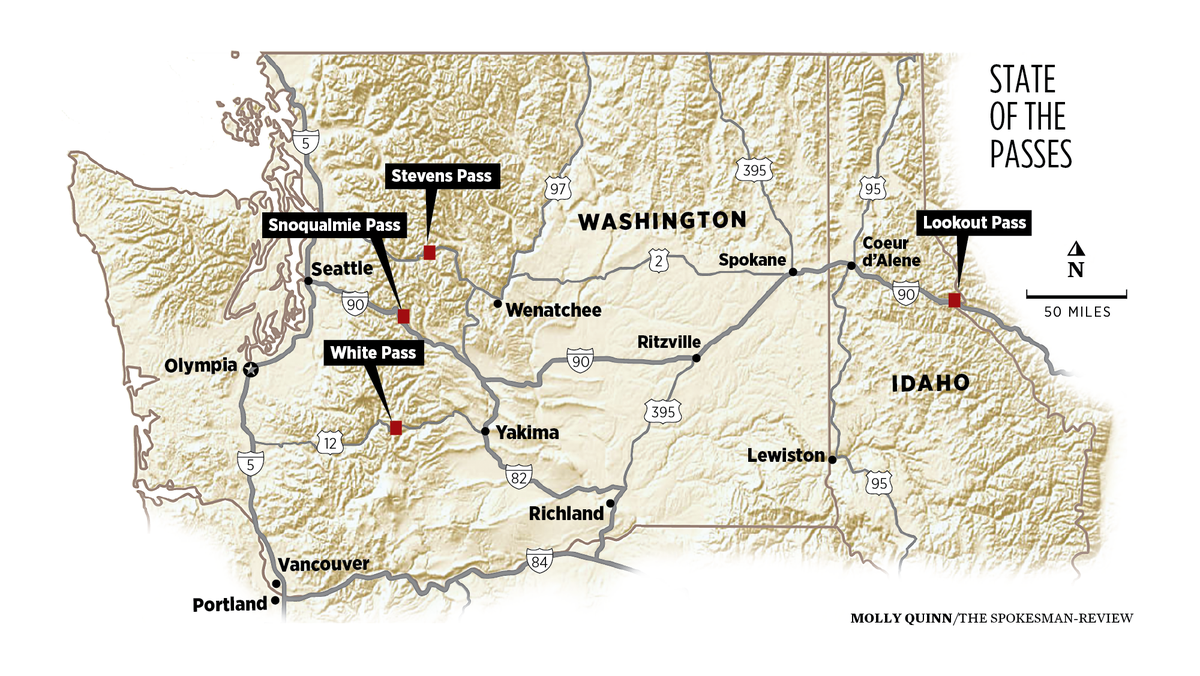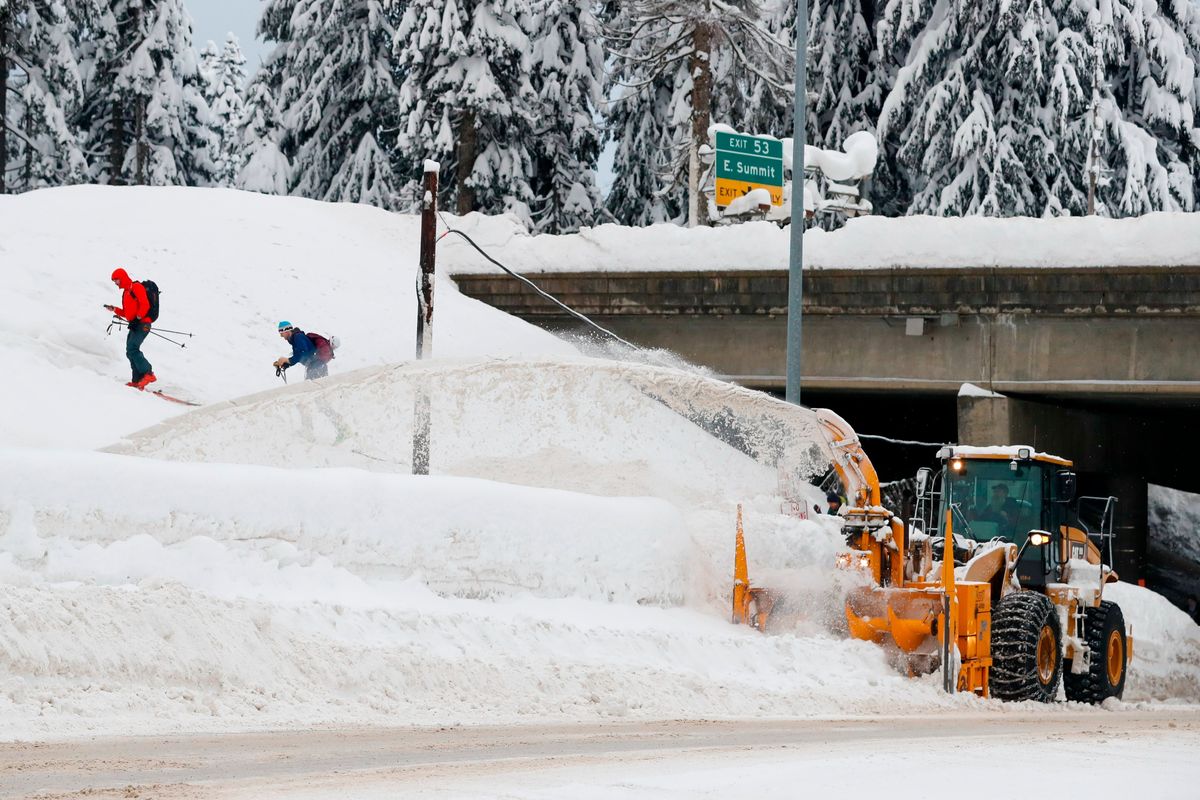Getting There: Mountain passes offer better way across the state, but this winter has been different
A Washington State Department of Transportation snowblower clears the road under I-90 at Summit West as backcountry skiers head up the Pacific Crest Trail after a heavy snowfall at Snoqualmie Pass. Authorities say Snoqualmie Pass has received the highest snowfall in 20 years as of Jan. 3. (Jennifer Buchanan)
This winter has already proved to be an intense one for Washington’s mountain passes, as arctic cold in December dumped dozens of inches of snow and caused one of the longest closures of the Snoqualmie and Stevens passes.
Crews with the Washington state Department of Transportation worked to keep the passes maintained. They could only do so much.
As of Sunday, Snoqualmie Pass had 292 total inches of snow, a near record-breaking season, said Summer Derrey, the department’s South Central region public information officer.
At Stevens Pass, the total snow accumulation was reported at 302 inches as of Sunday, according to the department of transportation’s snowfall report. Sherman Pass had a total of 90 inches, and as of Jan. 10 White Pass saw 148 total inches.
“We have not experienced weather events like this since I’ve been here for over 15 years. I can’t recall this,” Derrey said.
At Snoqualmie Pass, 19 inches of snow fell in one day Jan. 3, the largest daily amount recorded since the season began in October, according to the transportation department’s snowfall report.
“We have been seeing a lot more snow through December into early January, and we’ve caught up at least at the (Spokane International) airport,” said Steven Van Horn, a meteorologist with the National Weather Service in Spokane.
The passes do not close often, Derrey said. When they do, it’s usually based on three factors: bad drivers, avalanche control and intense weather.
“This winter, we’ve had more closures related to semis that have just spun out and blocked the highway for everyone,” Derrey said. “So that is primarily why it closes, is due to spinouts, and just cars and/or semi trucks blocking the highway.”
Snoqualmie Pass closed for 90 hours between Jan. 6 and Jan. 9.
In her time at the transportation department, Derrey said it’s one of the longest times the pass has been closed.
The region saw more winter storm systems this year, Van Horn said. Rain and snowfall in Spokane has run above-average since October, he said.
“That really built up the snowpack,” Van Horn said.
It put a slight dent in the statewide drought that’s parched nearly every part of Washington, Van Horn said, but there’s still a long way to go before it ends.
When weather events are this bad, even state plows can’t reach the mountains, Derrey said.
“Basically on I-90, we had a high amount of snowfall in a very short amount of time, which filled up the avalanche paths,” she said. “On top of that there are multiple issues with basically the weight of the snow hanging on the trees.”
After dozens of inches of snow has fallen, car crashes become common, Derrey said. Lots of drivers believe they can out-drive bad weather, she said.
Spokane was not immune to the icy roads, with Spokane Police tweeting on Dec. 6 they saw more than 100 crashes in a day after nearly 2 inches of snow fell.
Crossing the passes has always been a tricky endeavor. Until 1931 the Snoqualmie Pass had never stayed open during the entire winter season, according to the Washington state Department of Transportation I-90 Snoqualmie East Project page.
Indigenous communities had already made foot trails over the mountains when colonizers arrived, the project page said. Though wagon trails were added in the 1800s to the West Side, on the East Side of the Cascades only foot trails helped travelers get across.
The first car passed over the mountains in 1905, the same year the Washington State Department of Highways upgraded the roads and constructed the later-rebuilt two-lane Sunset Highway in 1915. In 1934 the department took on a plan to build a 17-mile stretch of road starting at Snoqualmie’s summit.
Rest areas and amenities cropped up around the newly renamed Interstate 90, and by the 1970s major projects helped make the pass safer, according to the project page.
But bad weather can trump even the best construction efforts. When the passes closed Jan. 6 it was because even state maintenance crews couldn’t safely navigate the roads, Derrey said.
As winter continues, Derrey said Snoqualmie and White passes are on track to see the most snowfall they’ve seen in two decades.
“We have surpassed three seasons already just for their total snowfall,” she said. “Of course those are drought years.
“I-90 on average gets about, you know, 400 or so inches of snow per year, and then we’re at about 300 right now. And the winter is not over yet. We usually get quite a bit of snowfall in February, so we’re gonna keep an eye out for that month.”
Work to watch for
The westside curb lane of Thor Street between Pacific and Third Avenues, near the bridge over Interstate 90 in the East Central neighborhood, will be closed Tuesday for signal work.
The northbound center lane of Division Street at Francis Avenue in north Spokane will be closed Tuesday for signal work.
Nevada Street between North Foothills Drive and Francis Avenue will have a single lane closure on Wednesday.


